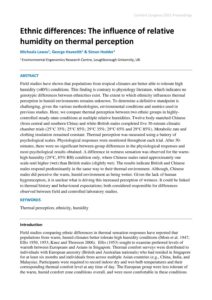| Document | Author Micheala Lawes, George Havenith & Simon Hodder |
| Abstract A protocol was developed to test theoretical assumptions associated with the interrelationship between thermal sensation, thermal discomfort, and physical contact temperatures in humans. To achieve this, perceptual responses (thermal sensation and thermal discomfort) to the application of seventeen absolute physical temperatures, ranging from cold to hot (18 - 42°C) were examined. In addition, the present study tested the confidence of participants in their thermal sensation ratings also, across a wide spectrum of thermal stimuli. Seventeen Western European university students volunteered and consented to participate in the study. The location of the application of the probe was marked on their skin, ensuring consistent application across temperatures, and all participants were blinded to the environment conditions, as well as the temperature of thermal probe controller unit, to avoid expectation bias. Physical temperatures were applied with a conductive thermal probe (Physitemp Instruments Inc., USA) consisting of a 25 cm2 metal surface, applied with a pressure of 4 kPa, in a mixed counterbalanced order. The probe was applied to the skin for 10 seconds for all applications, at the end of which participants rated their local thermal sensation, the confidence of thermal sensation, and local thermal discomfort. A recovery time between thermal probe applications of at least 20 seconds was used. Local skin temperature has been reported to have returned to its baseline value using a single spot infrared thermometer (FLUKE 566, Fluke Corporation, USA) prior to each subsequent thermal probe application. |

